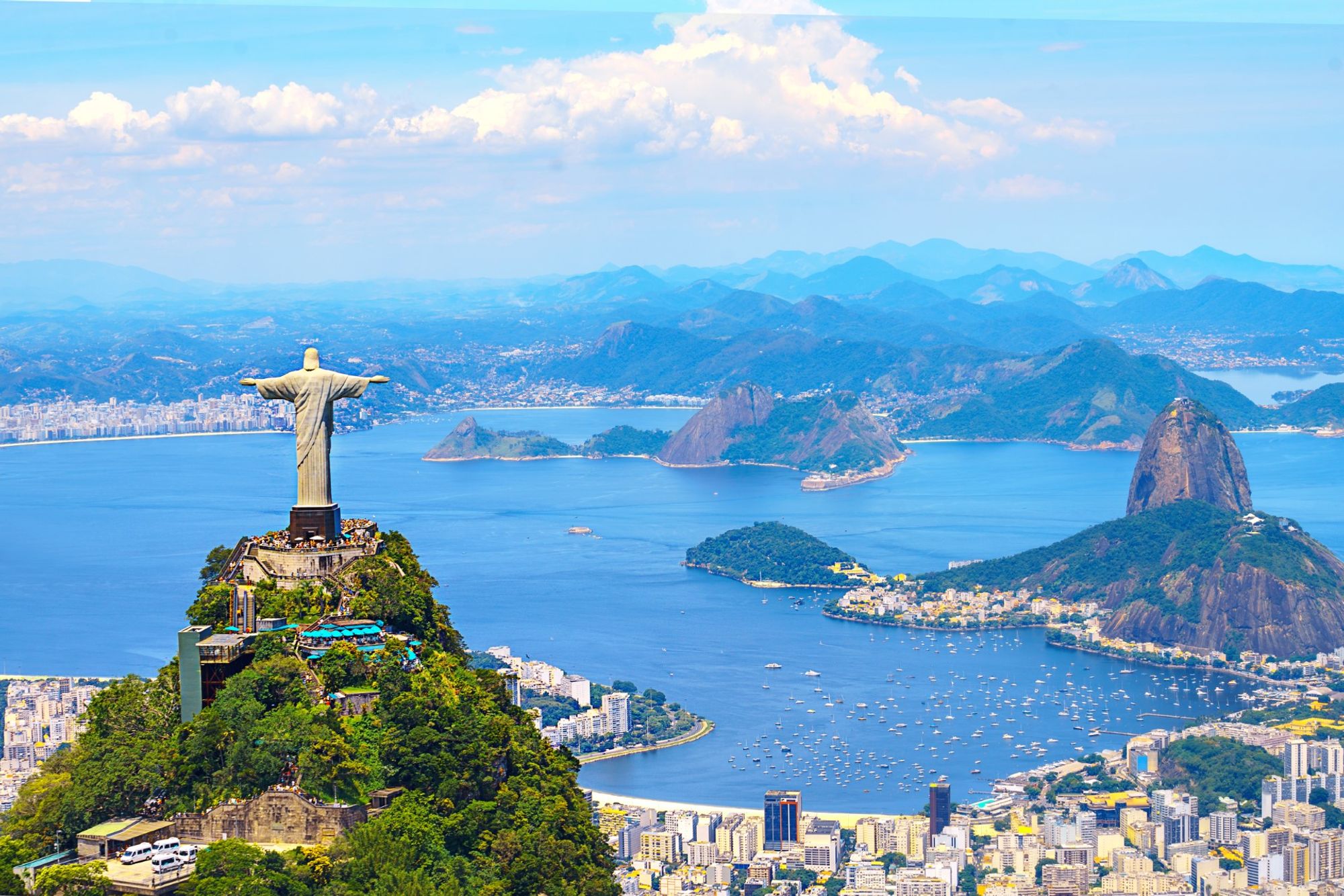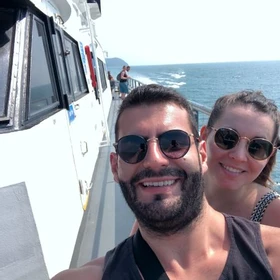About the ride from Ilha Grande to Rio de Janeiro
Say farewell to Ilha Grande's island beauty and exchange it for the magic of Brazil's capital city, Rio de Janeiro.
Located 111 kilometers (68.9 miles) away from the idyllic island, this bustling capital will soon sweep you off your feet.
To reach the city, choose between taking a bus and ferry, a minivan and ferry, or a private car transfer and ferry combination.
The bus and minivan options are perfect for solo travelers eager to save cash and meet new friends. The private car transfer is ideal for luxury travelers seeking privacy and convenience.
What is Rio de Janeiro like?
Rio de Janeiro has earned its nickname Cidade Maravilhosa (Marvelous City) ten times over.
The vast metropolis sits at the mouth of a bay surrounded by white-sand beaches and luscious green mountains covered in tropical forest.
Whichever way you look, there are dramatic views to take in. The 123-foot-tall Christ the Redeemer statue is by far the most iconic thing on the horizon, but the city has numerous other gems to discover as well.
Rio de Janeiro is always alive with activity; it's like the New York City of South America. By day, you'll join locals and tourists flocking to the beaches to sunbathe, play volleyball, and surf. And by night, you'll dive into the thriving nightlife and dance to samba beats as you bar hop through the city.
Pro tip: Be aware of your surroundings! There are still some dangerous areas of the city, so stay cautious and keep hold of your valuables.
Five unforgettable activities in Rio de Janeiro
Rio de Janeiro is a capital city thriving with activity, meaning you'll struggle to tick off everything on your list before heading home. Keep these activities at the top of your list when planning your itinerary.
Hike to the Christ the Redeemer Statue. Visiting Rio isn't complete without seeing the Christ the Redeemer statue. The statue, which sits atop Mount Corcovado, was completed in 1931 and still attracts numerous visitors daily. If you're brave, take on the hike or opt for the train or minivan shuttle to reach the peak and enjoy the spectacular view of the city below.
Learn to surf. Rio de Janeiro is world-famous for its surfing opportunities, so where better to master this unique skill? Find an instructor on any of the city's beaches and dive into the waves to find your balance.
Explore the Parque Nacional da Tijuca. Rio de Janeiro was once all trees, but now this park is all that's left of the Atlantic Forest. The park protects 39 square kilometers (15 square miles) of jungle, preserving it for visitors and locals.
Visit the Museum of Tomorrow. This interactive museum explores the impact humans have had on the world and draws attention to projects promoting environmental sustainability to protect the world for tomorrow.
Take the cable car up Sugarloaf Mountain. Located in the mouth of Guanabara Bay and rising an impressive 393 meters (1289 feet) above the harbor, Sugarloaf Mountain is named for its resemblance to the shape of refined loaf sugar. More importantly, it offers picturesque views of the bay and the city.
How do I get from Ilha Grande to Rio de Janeiro?
Travelers going from Ilha Grande to Rio de Janeiro have several options, but they all involve taking a ferry back to the mainland from the island.
After the ferry, you can reach Rio de Janeiro by bus, minivan, or car.
By bus + ferry
Paraty Tours and IN Buzios offer bus and ferry combination services. Tickets, which include ferry transfers, start at $45. This service departs from Abraao Tourist Pier, and you can request a drop-off at your hotel in the city or one of the airports: Rio de Janeiro-Santos Dumont Airport or Carlos Jobim International Airport.
The journey will take approximately 2.5-4.5 hours, depending on the operator, traffic and arrival spot.
Possible amenities include:
Air conditioning
WiFi
A luggage allowance of 23-25kg (50-55lbs) and one handbag
Because this option is a shared service, you may need to wait for other passengers. After the ferry ride, you could wait between one and two hours for the rest of your group. Due to high season traffic, expect longer waits between December and March.
By bus
Buzios Transfer operates buses that travel from Ilha Grande to the heart of Rio.
The details describe it as a "bus" option because the ticket does not include the cost of the ferry ticket.
However, this option still involves a ferry crossing, and you'll need to buy a ferry ticket at the port. This option costs $26 for a one-way journey. The ferry ticket will cost around 70 Brazilian reals ($13).
This service departs from the Abraao Tourist Pier and drops you off at your chosen hotel in Rio de Janeiro. You can also select an option that drops off at Rio de Janeiro-Santos Dumont Airport or Antonio Carlos Jobim International Airport.
By minivan + ferry
If you want to travel with fewer people, opt for a minivan and ferry combination. Tickets start at $27.
Easy Transfer Brazil and Top Transfer operate this service.
Services depart from Abraao Tourist Pier or Aracatiba Port. From there, you'll drive to Rio de Janeiro and get dropped off at your hotel, the Rio de Janeiro-Santos Dumont Airport, or the Carlos Jobim International Airport.
Possible amenities include:
Air conditioning in the minivan
A luggage allowance of 23kg (50lbs) and one handbag
This is also a shared service, meaning you might need to wait for additional passengers after the ferry before departing for the city.
By car + ferry
If you want to enjoy a little peace and comfort, book a ferry and private car transfer.
After a quick 30-minute ferry departing from Abraao Tourist Pier and arriving at Santa Luzia Pier, your driver will pick you up.
The driver can take up to three passengers per car and will drop you off at your chosen hotel or airport in Rio de Janeiro. This option takes around 4-4.5 hours to reach the city. Prices start at $333 per car.
The best things about the trip from Ilha Grande to Rio de Janeiro
It's all about the views!
When hopping back to the mainland by ferry, you'll be dazzled by the sparkling blue water and seemingly endless horizon panoramas.
The ferry ride is the most exciting part, though. For the drive into the capital, put on your headphones and catch up on some sleep.
When is the best time to visit Rio de Janeiro?
The best time to visit Rio de Janeiro is in February, just in time for Carnival! You'll find yourself in the middle of the world's most epic street parties or blocos and colorful parades.
Partiers come from around the globe to experience Brazil's Carnival, and you'll soon see why.
However, Brazil is a year-round destination thanks to its location on the equator. Spring, between September and November, is a quieter time to visit if you don't want to get caught up in the carnival crowds.
Temperatures are around 79°F (26°C), which is still warm enough to sunbathe and hike up to see Christ the Redeemer.
How many days should I spend in Rio de Janeiro?
Three to five days is more than enough time to spend in Rio de Janeiro. It might seem like too little time to experience everything this incredible city offers, but it's just enough time to get a taste before moving on to your next destination.
Three days is enough time to visit the top sites, spend a day relaxing on the beach, and spend a night partying amid the city's thriving nightlife.
If the city's magnetic energy pulls you in, consider booking up to a week's accommodation to immerse yourself in the city's culture.
Where should I go after Rio de Janeiro?
After mining Brazil's capital city for its many cultural gems, switch it up with a visit to Cabo Frio to experience a quieter town with equally epic views. Spend a few days visiting the stunning beaches surrounding neighboring Arauama Lagoon before visiting the nearby island to discover the famous Blue Grotto.
Alternatively, head north to Petropolis and immerse yourself in Serra dos Órgãos National Park. The area is a popular mountain retreat for Rio's residents and is littered with forested peaks and waterfalls.
















